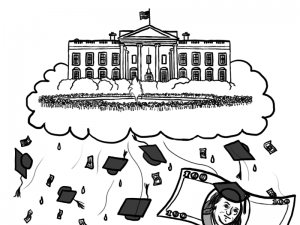Free college plan ignores important issues
Last week, President Barack Obama announced the proposal, dubbed “America’s College Promise,” to provide free community college tuition nationwide — a concept that, while bold and revolutionary, requires a closer look at its effectiveness. Though the proposal faces opposition in the Senate, presumably because of the $60 billion price tag, it is the ineffective measures of the bill itself that warrant reconsideration.
Advocates of Obama’s proposal praise his initiative to finally solidify an executive commitment to the affordability of college, and indeed, the astronomical cost of college is perhaps the biggest crisis facing higher education. The price of higher education in the United States becomes even more absurd when pitted against international counterparts; according to a 2010 report by the International Ranking Expert Group Observatory on Academic Ranking and Excellence, the United States had the highest student cost at $13,856, while the second and third were Finland at $1,243 and Germany at $933 respectively. It is almost impossible to believe that the United States provides higher education at more than 11 times the price of the next priciest country. For lower income communities, the price of college is an especially cruel catch-22; a country that prizes higher education as the gateway to a better financial life requires financial means.
It is not wrong, then, to tout that this presidential push for reform will incite reservations about the most effective approaches to improving higher education. But through these conversations, the futility of the practical effects of this specific proposal will hopefully make itself apparent.
At face value, the notion of making college “the norm in the same way high school is the norm now,” as White House Director of Domestic Policy Cecilia Muñoz said, seems noble. And transforming the K-12 model to essentially a K-community college model seems like exactly the solution that a generation of debt-ridden college students have been begging for — a silver bullet to providing more skills and access aimed at a low-income demographic unable to afford college or the private loans they may be forced to take out. But the greatest obstacle the proposal faces is that its target demographic just misses the mark — the poorest students qualify for Pell grants, which cover the cost of community college, leaving middle-class students, who can usually afford community college anyway. The $60 billion supports students who don’t really need it.
The proposal tries but fails to close the education access gap between the rich and the poor. If the federal government is really committed to making college universal, then they must more carefully scrutinize the access barriers that prevent 80 percent of community college students from getting their degree in three years, instead of assuming that attrition is due to high tuition costs. Rather than spending $60 billion on eliminating community college tuition, the federal government can spend it to improve community college programs and resources which can keep students on track for graduation.
Admittedly, Obama’s proposal made some commitment, however lackluster it may be, to improving the quality of community colleges by including a clause that requires community colleges to prove “promising and evidence-based institutional reforms” to receive the federal tuition money. These institutional reforms should be the basis of a bill to change the landscape of community colleges, not a side provision. Educators and politicians should meet to consider optimization of resources and individualized attention so that community colleges can keep their students motivated to complete their degree program.
The Obama administration was correct in assessing that college tuition is too expensive. They targeted the wrong students, for many of whom tuition remains a major barrier. At Los Angeles City College, a major community college in Los Angeles, tuition is at most $1,656 a year. Compare that cost with tuition at UCLA, the closest major public four-year university — $12,696 for the academic year. If the federal government is looking for low-income college students to support, those who attend four-year universities are in desperate need.

